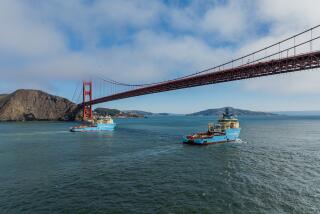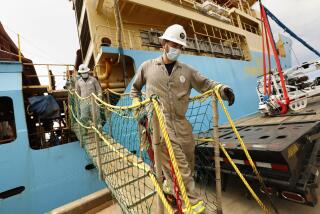Plastic Trash Presents Major Peril to Marine Life, Scientists Warn
- Share via
PACIFIC GROVE — Plastic trash in the oceans is maiming and killing fish, turtles, seals and sea birds, posing a threat to marine life that rivals oil spills and toxic chemicals, scientists warned Tuesday.
Sea animals, including endangered species, are not only becoming entangled in discarded fishing nets but also mistaking small pieces and sheets of plastic as food, often with fatal results.
“It’s occurring over almost every marine species to some degree,” James Coe of the U.S. National Oceanic and Atmospheric Administration said here during the sixth annual Ocean Disposal Symposium.
“Education is one of our real only hopes,” added Nancy Monroe, an Alaska publicist who is under a federal contract to help develop an education campaign against ocean pollution. “The laws prohibiting dumping are vague at best.”
Coe and other scientists said ocean pollution will almost certainly worsen before improving, because plastics are fast replacing biodegradable natural packaging materials and because there appears to be few effective laws or international treaties to regulate ocean pollution.
The primary sources of plastics in the ocean are trash from ships, litter carried to the sea by rivers and storm water drainage systems and items left behind by beachgoers.
In addition, fishing fleets are said to be responsible for dumping 26,000 tons of plastic packaging materials each year into the seas and for losing or discarding another 150,000 tons of non-degradable fishing gear, according to researchers at the symposium.
Plastic debris has washed up on remote islands in the Antarctic and the beaches of Amchitka Island in the western Aleutians, researchers said.
On Midway and Oahu islands, 90% of 50 Laysan albatrosses and wedge-tailed shearwaters, some of them already dead, were found to have plastics in their upper digestive tracts. Some died of ulcers. Others starved or were unable to regurgitate food for chicks.
Charles W. Fowler of the National Marine Mammal Laboratory in Seattle said a statistical analysis indicates that there is a connection between the declining population of northern fur seals of the Pribilof Islands north of the Aleutians and an increasing incidence of entanglement in lost or discarded fishing nets. Among the most vulnerable to plastics are sea turtles, which are on the endangered species list, because they mistake them for one of their favorite foods, jelly fish, according to Archie Carr, a University of Florida zoologist.
Ronald Bruner of the Washington-based Society of the Plastics Industry, said in a telephone interview that plastics manufacturers are concerned about the pollution of the oceans. However, he added, “how much of it is our problem and how much of it is the way the product is handled once it leaves our hands?”
Bruner also said that suggestions that plastics be made degradable would often conflict with a demand by consumers for lasting or strong products.
More to Read
Sign up for Essential California
The most important California stories and recommendations in your inbox every morning.
You may occasionally receive promotional content from the Los Angeles Times.













